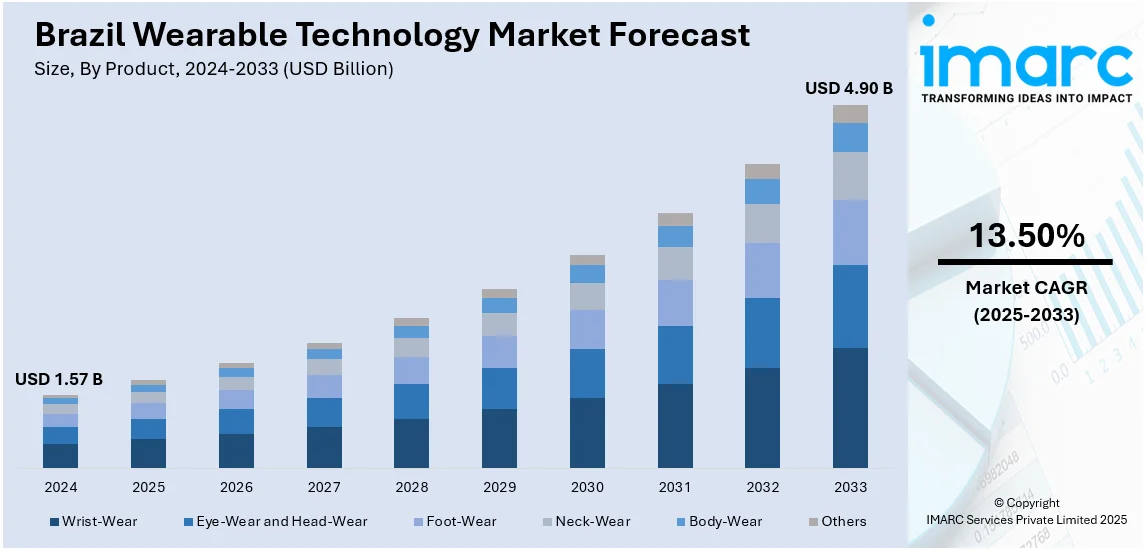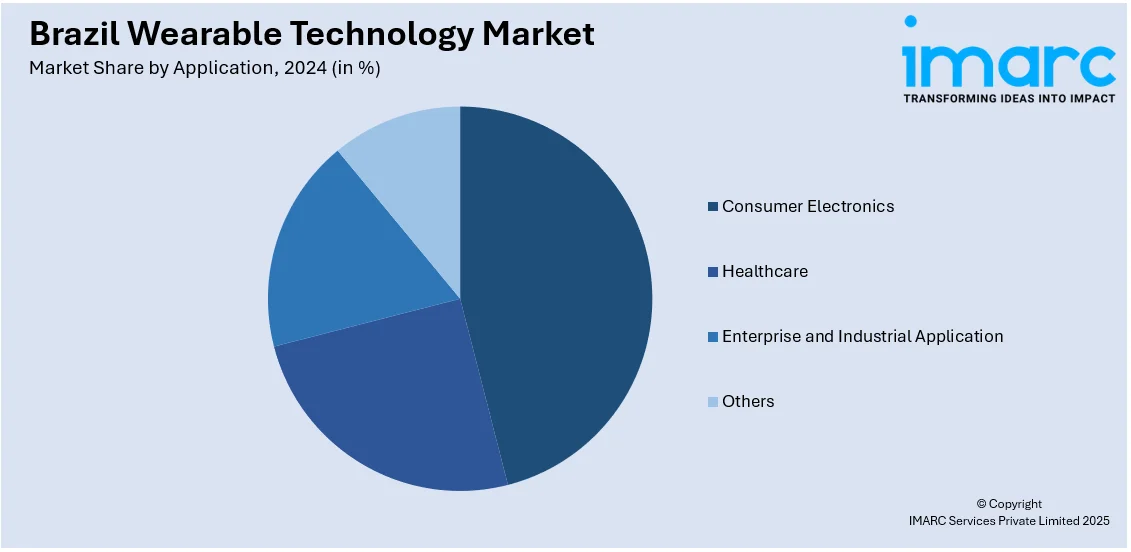
Brazil Wearable Technology Market Size, Share, Trends and Forecast by Product, Application, and Region, 2025-2033
Brazil Wearable Technology Market Size and Share:
The Brazil wearable technology market size reached USD 1.57 Billion in 2024. Looking forward, IMARC Group expects the market to reach USD 4.90 Billion by2033, exhibiting a growth rate (CAGR) of 13.50% during 2025-2033. The Brazil wearable technology market share is increasing due to the growing focus on health awareness, coupled with advancements in wearable technology. Smartwatches and fitness bands are evolving with enhanced health monitoring features and internet of things (IoT) integration, offering users greater convenience, real-time insights, and seamless connectivity across various smart ecosystems.
|
Report Attribute
|
Key Statistics
|
|---|---|
|
Base Year
|
2024
|
|
Forecast Years
|
2025-2033
|
|
Historical Years
|
2019-2024
|
| Market Size in 2024 | USD 1.57 Billion |
| Market Forecast in 2033 | USD 4.90 Billion |
| Market Growth Rate (2025-2033) | 13.50% |
Brazil Wearable Technology Market Trends:
Growing Health and Fitness Adoption
Wearable devices like fitness trackers and smartwatches are being more frequently utilized to track sleep patterns, heart rate, and physical activities. This trend is mainly fueled by the increasing prevalence of chronic illnesses and a growing health-aware demographic. Additionally, the increasing elderly population, which is more susceptible to health issues, is driving the expansion of the market. According to the IBGE article updated in 2024, from 2000 to 2023, the proportion of elderly people (aged 60 and older) in Brazil's population almost doubled, rising from 8.7% to 15.6%. By the year 2070, approximately 37.8% of the nation's population will be aged 60 years or more. With citizens in the nation increasingly prioritizing preventive healthcare, it's expected that wearable devices will be essential for managing and monitoring individual health information. Moreover, the integration of health-focused applications and advanced sensors in wearables is boosting adoption nationwide, setting the stage for continued market growth.

Increasing Demand for Smartwatches
Smartwatches are quickly becoming popular in the Brazilian market, as users demonstrate increased interest in devices that offer improved versatility, connectivity, and convenience. Their capacity to connect with smartphones, utilize different applications, and receive alerts has enhanced the attraction of smartwatches beyond just fitness monitoring. Furthermore, as more people purchase smartwatches for everyday use, such as for entertainment and communication, the demand is rising considerably. Additionally, the introduction of new products with better health features, longer battery life, and stylish designs is driving market expansion. This trend emphasizes a significant shift towards advanced technological devices that integrate functionality and lifestyle into one platform. For example, in 2024, Huawei launched four new smartwatches in Brazil, highlighting health features and extended battery life. Notable models included the Huawei Watch D2, offering ambulatory blood pressure monitoring, as well as the Huawei Watch GT 5 series, which claims a battery life of up to 14 days. The devices created for health monitoring, workout tracking, and offer advanced features for elite athletics.
Expanding Internet of Things (IoT) Incorporation
The increasing integration of wearables within internet of things (IoT) ecosystems is transforming the Brazil wearable technology sector. Wearables linked through IoT are allowing effortless communication among devices, helping users manage different features of their smart homes, cars, and personal devices. Furthermore, wearables today serve as central units for managing IoT-enabled systems, increasing their value proposition. This phenomenon is particularly significant in Brazil, where the growing adoption of smart homes is boosting the demand for connected wearables. Moreover, as IoT technologies advance, the compatibility between wearables and other smart devices will greatly impact market growth, encouraging creative applications across different industries. A study conducted by the Brazilian Association of Internet of Things (ABINC) in collaboration with ISG Provider Lens suggests that the total count of connected devices in Brazil might hit 27.1 billion by 2025.
Brazil Wearable Technology Market Segmentation:
IMARC Group provides an analysis of the key trends in each segment of the market, along with forecasts at the regional level for 2025-2033. Our report has categorized the market based on product and application.
Product Insights:
- Wrist-Wear
- Eye-Wear and Head-Wear
- Foot-Wear
- Neck-Wear
- Body-Wear
- Others
The report has provided a detailed breakup and analysis of the market based on the product. This includes wrist-wear, eye-wear and head-wear, foot-wear, neck-wear, body-wear, and others.
Application Insights:

- Consumer Electronics
- Healthcare
- Enterprise and Industrial Application
- Others
A detailed breakup and analysis of the market based on the application have also been provided in the report. This includes consumer electronics, healthcare, enterprise and industrial application, and others.
Regional Insights:
- Southeast
- South
- Northeast
- North
- Central-West
The report has also provided a comprehensive analysis of all the major regional markets, which include Southeast, South, Northeast, North, and Central-West.
Competitive Landscape:
The market research report has also provided a comprehensive analysis of the competitive landscape. Competitive analysis such as market structure, key player positioning, top winning strategies, competitive dashboard, and company evaluation quadrant has been covered in the report. Also, detailed profiles of all major companies have been provided.
Brazil Wearable Technology Market News:
- In December 2024, Vivo launched a new sub-brand, JOVI, in Brazil. The first devices under this sub-brand would include JOVI V50, V50 Lite 5G, Y39 5G, and wearables.
- In September 2024, Samsung’s Galaxy Ring was launched in two new sizes, 14 and 15, extending its former range of sizes from 5 to 13. The health-monitoring smart ring was launched in additional areas, including Brazil, where pre-orders were already initiated.
Brazil Wearable Technology Market Report Coverage:
| Report Features | Details |
|---|---|
| Base Year of the Analysis | 2024 |
| Historical Period | 2019-2024 |
| Forecast Period | 2025-2033 |
| Units | Billion USD |
| Scope of the Report |
Exploration of Historical Trends and Market Outlook, Industry Catalysts and Challenges, Segment-Wise Historical and Future Market Assessment:
|
| Products Covered | Wrist-Wear, Eye-Wear and Head-Wear, Foot-Wear, Neck-Wear, Body-Wear, Others |
| Applications Covered | Consumer Electronics, Healthcare, Enterprise and Industrial Application, and Others. |
| Regions Covered | Southeast, South, Northeast, North, Central-West |
| Customization Scope | 10% Free Customization |
| Post-Sale Analyst Support | 10-12 Weeks |
| Delivery Format | PDF and Excel through Email (We can also provide the editable version of the report in PPT/Word format on special request) |
Key Questions Answered in This Report:
- How has the Brazil wearable technology market performed so far and how will it perform in the coming years?
- What is the breakup of the Brazil wearable technology market on the basis of product?
- What is the breakup of the Brazil wearable technology market on the basis of application?
- What is the breakup of the Brazil wearable technology market on the basis of region?
- What are the various stages in the value chain of the Brazil wearable technology market?
- What are the key driving factors and challenges in the Brazil wearable technology market?
- What is the structure of the Brazil wearable technology market and who are the key players?
- What is the degree of competition in the Brazil wearable technology market?
Key Benefits for Stakeholders:
- IMARC’s industry report offers a comprehensive quantitative analysis of various market segments, historical and current market trends, market forecasts, and dynamics of the Brazil wearable technology market from 2019-2033.
- The research report provides the latest information on the market drivers, challenges, and opportunities in the Brazil wearable technology market.
- Porter's five forces analysis assist stakeholders in assessing the impact of new entrants, competitive rivalry, supplier power, buyer power, and the threat of substitution. It helps stakeholders to analyze the level of competition within the Brazil wearable technology industry and its attractiveness.
- Competitive landscape allows stakeholders to understand their competitive environment and provides an insight into the current positions of key players in the market.
Need more help?
- Speak to our experienced analysts for insights on the current market scenarios.
- Include additional segments and countries to customize the report as per your requirement.
- Gain an unparalleled competitive advantage in your domain by understanding how to utilize the report and positively impacting your operations and revenue.
- For further assistance, please connect with our analysts.
 Inquire Before Buying
Inquire Before Buying
 Speak to an Analyst
Speak to an Analyst
 Request Brochure
Request Brochure
 Request Customization
Request Customization




.webp)




.webp)












